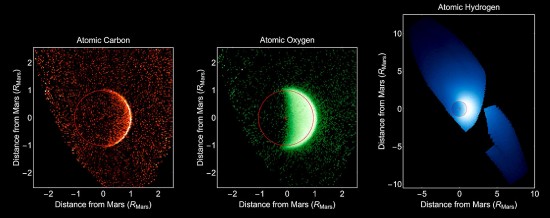
Three views of an escaping atmosphere, obtained by MAVEN’s Imaging Ultraviolet Spectrograph. Credit: NASA/Univ. of Colorado
Nov 9, 2015
Was Mars once warm and lush?
NASA launched the Mars Atmosphere and Volatile Evolution Mission (MAVEN) on November 18, 2014 on a year-long investigation of Mars’ upper atmosphere, its ionosphere, and how it interacts with the solar wind. The spacecraft is fitted with instruments that are monitoring various phenomena that add valuable information to the theory of an Electric Universe:
- Solar Wind Electron Analyzer to measure ionospheric electrons.
- Solar Wind Ion Analyzer to measure the magnetosheath ion density.
- Langmuir Probe to determine ion escape wave heating and extreme ultraviolet input from the Sun.
- Ultraviolet Spectrometer to measure characteristics of the upper atmosphere.
- Magnetometer to measure the Martian remanent magnetic field.
The consensus view of Mars is illustrated by a past press release discussing the MAVEN mission: “Once upon a time—roughly four billion years ago—Mars was warm and wet, much like Earth. Liquid water flowed on the Martian surface in long rivers that emptied into shallow seas. A thick atmosphere blanketed the planet and kept it warm.”
A recent announcement by MAVEN mission investigators states that Mars is losing atmospheric gases to space at about 100 grams per second, or around 3,100,000 kilograms per year. That means Earth would resemble how planetary scientists think Mars devolved in about 5 billion years. What happened to Mars is a matter of speculation. However the research team believes Mars was once like Earth in another way, it possessed an electromagnetic field. When the planet’s internal dynamo cooled and solidified, it was unable to maintain its shield against solar wind ions.
What process caused the core to cool is not known, since Earth is thought to also have a liquid iron core that developed at the same time as Mars. Earth and Mars are believed to have come into existence in a planetary nebula as siblings.
The equatorial diameter of Mars is approximately 6793 kilometers, about half that of Earth. Currently, the average temperature is minus 63 Celsius, compared to Earth at plus 13 Celsius. The atmospheric density on Mars is less than 1% that of Earth, or the equivalent to standing on top of a mountain six times taller than Mount Everest.
Mars is also thought to be covered with a planet-wide layer of permafrost because the annual mean temperature of the soil is so low. In the northern and southern latitudes it is so cold that carbon dioxide freezes into a solid, burying the terrain in dry ice. That cold is what caused the end of the Phoenix mission: the lander was encased in almost a meter of dry ice during the winter. The atmosphere is so thin that water-ice will sublime directly into vapor. How did Earth and Mars diverge so dramatically?
At the low point in its elliptical orbit, MAVEN comes within 125 kilometers of the surface. At its high point, it reaches 6000 kilometers out, therefore the mission team hopes to gather enough data to answer the question of why so much carbon dioxide remains when most of the other gases are gone before the planned end of its science mission on November 16, 2015.
Questions from Electric Universe advocates might also include: What is the relationship to planetary atmospheres and the behavior of an electric Sun? Can present conditions on Mars provide examples of an electrical connection? Do present conditions on Mars offer analogues that can provide clues to the catastrophic events in the planet’s recent past?
The history of the planets is difficult to determine. In the Electric Universe view, each of them took part in several catastrophic events. The most recent of those events left its mark incised on planetary bodies, as previous Pictures of the Day insist. Without considering past catastrophic events that engulfed the Solar System, questions will remain and Mars will continue to be “mysterious”.
Stephen Smith












